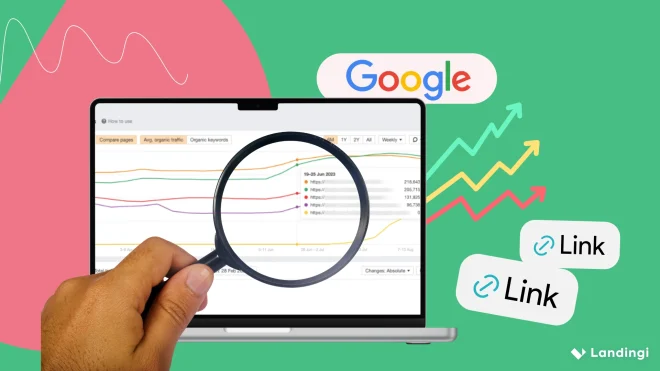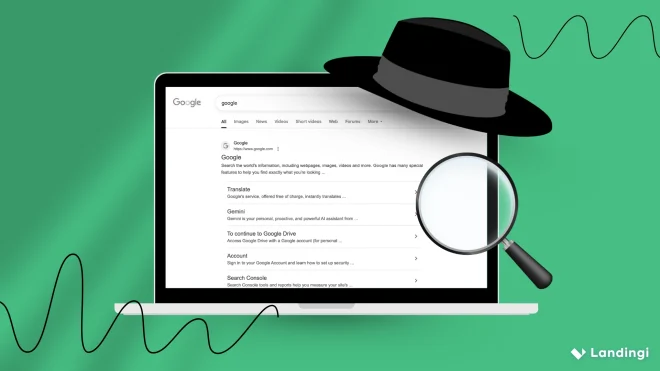SEO competitor analysis is the process of comparing your website with those that rank higher for the same search queries. It helps uncover how competitors structure content, build backlinks, target keywords, and drive organic traffic. With a massive 39.8% CTR for the #1 Google spot dropping sharply for lower positions (FirstPageSage), SEO competitor analysis is crucial. It reveals how top sites capture those valuable clicks, guiding your optimization to improve your own rankings.
SEO competitor research lets you understand the strategies behind your competitors’ visibility and identify which elements influence their rankings. This step-by-step guide will walk you through how to do a smart competitor analysis, which tools can help, and how to use what you learn. Going through this process thoroughly will help you uncover any weak spots in your own site’s structure, missing content, and opportunities to boost your search performance.
Ready to boost your rankings? Check out what you can learn by analysing your SEO competitors’ rankings.

What Is Competitor Analysis in SEO?
Competitor analysis in SEO involves identifying, evaluating, and benchmarking your search engine optimization strategy against websites that rank for the same or similar queries. As defined in the training materials from the Topical Authority Course by Koray Tuğberk GÜBÜR, competitor analysis serves as a foundational component of topical authority development by revealing the contextual and semantic structures your rivals use to outrank you.
Simply put, it’s all about identifying the websites that are your rivals for the same search terms and then digging into what they’re doing with their SEO. The goal? To learn from their successes (and avoid their mistakes) so you can boost your own website’s ranking.
What’s the Importance of Competitor Analysis in SEO?
The importance of competitor analysis in SEO lies in its ability to improve ranking efficiency, reduce retrieval costs, and align your content with proven user expectations. Think of it this way: looking at your competitors helps you understand why certain strategies work in your niche. You can see how the top brands are building their authority by organizing their content, how often they post, and how everything fits together thematically. By spotting the key connections they’re making – like the specific details they focus on and the related ideas they link together – you can learn what Google and users are responding to and build on that.
This approach significantly increases your chances of:
- Ranking for primary and secondary queries
- Being recrawled and reindexed during Core Algorithm Updates
- Entering higher traffic threshold boxes, where search engines assign superior visibility
The whole process is not just about spying – it’s more about working smarter, not harder. When you see what’s already ranking well, you get a much clearer picture of what Google and users actually want. That means you can fine-tune your own approach, get better results faster, and avoid wasting time and resources on things that aren’t likely to work. Plus, when you know what resonates with your audience based on what’s already out there, you can create content that really hits the mark.
Know your competitors—then outrank and outconvert them with Landingi!
How to Do Competitor Analysis in SEO?
To perform effective competitor analysis in SEO, focus not just on keywords but on how your competitors organize their websites and maintain search engine attention over time. Ultimately, you want to figure out how they create semantic relevance and make it easier for Google to see their pages as the go-to resources.
There are four key areas to focus on: entity and attribute mapping, semantic content network, topical map depth, and query clustering and ranking paths. Entity and attribute mapping helps uncover how competitors base their content around specific entities and relevant attributes. By analyzing their coverage of these pairs (e.g., “Germany” and “Visa”), you can identify structural advantages in their topical hierarchy. This analysis also clarifies which attributes are prominent, popular, and essential in their content strategies.
Semantic content network (SCN) analysis involves tracking how internal links are distributed. Competitors that rank well often link from high-relevance nodes (main monetized pages) to supportive articles, creating logical, semantically connected pathways that guide crawlers. Identifying these link hierarchies lets you improve your own contextual bridges and PageRank flow.
Topical map depth shows how comprehensive a competitor is in both monetizable and informational aspects of the topic. Sites that cover both layers — the core (e.g., visa types, fees) and the outer (e.g., culture, safety, language) — build stronger topical authority and are harder to outrank. Evaluating this depth lets you find areas where you can go broader.
Finally, query clustering and ranking paths uncover which queries tend to appear together and in what sequence. If competitors rank for multiple steps in a search journey, such as “visa requirements” followed by “student visa application process,” it makes sense for you to create content that reflects that flow. This increases your visibility across sequential and correlative searches, improving total topical relevance.
7 Steps for Creating SEO Competitor Analysis
Creating an SEO competitor analysis is a structured process that starts with setting goals and identifying key rival websites to conduct keyword gap analysis, evaluate competitors‘ strategies, and, ultimately, leverage gathered insights to improve your own search engine rankings. However, rather than copying content, this process focuses on decoding semantic structures, topical depth, and contextual relationships that make a site rank efficiently.
Want to unlock some powerful insights from your top online rivals? These 7 steps will guide you through a data-driven competitor analysis:
- Set Your Goals
- Identify Key Competitors
- Conduct Keyword Gap Analysis
- Evaluate Competitors’ Content Strategy
- Evaluate Technical and On-Page SEO
- Analyze Competitors’ Backlink Profiles
- Turn Insights into Action
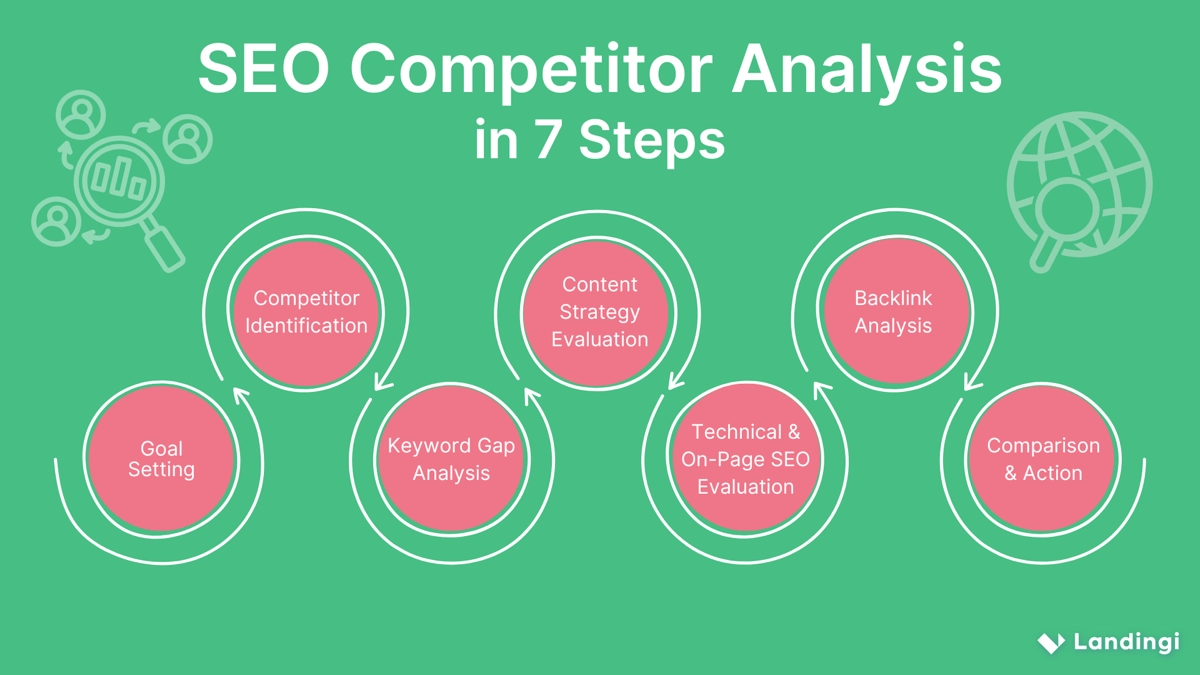
1. Set Your Goals
Before you even look at the competition, it’s important to know exactly what you’re hoping to achieve. Are you trying to rank higher for specific keywords, become a go-to resource on a topic, or maybe find new content ideas? Having a clear goal will help you determine which competitors to focus on and what numbers really matter – this clarity also ensures your SEO strategy remains focused on outcomes that support business growth.
2. Identify Your Key SEO Competitors
Then, identify your key SEO competitors. Concentrate on those websites ranking for the same keywords you’re targeting, rather than just focusing on direct business competitors. These search rivals often include niche blogs, directories, or content-driven platforms that dominate search visibility.
How to do it? Use tools like Ahrefs or Semrush to input your domain and generate a list of competing websites based on keyword overlap. Prioritize those with high topical coverage and consistent presence across the SERPs.
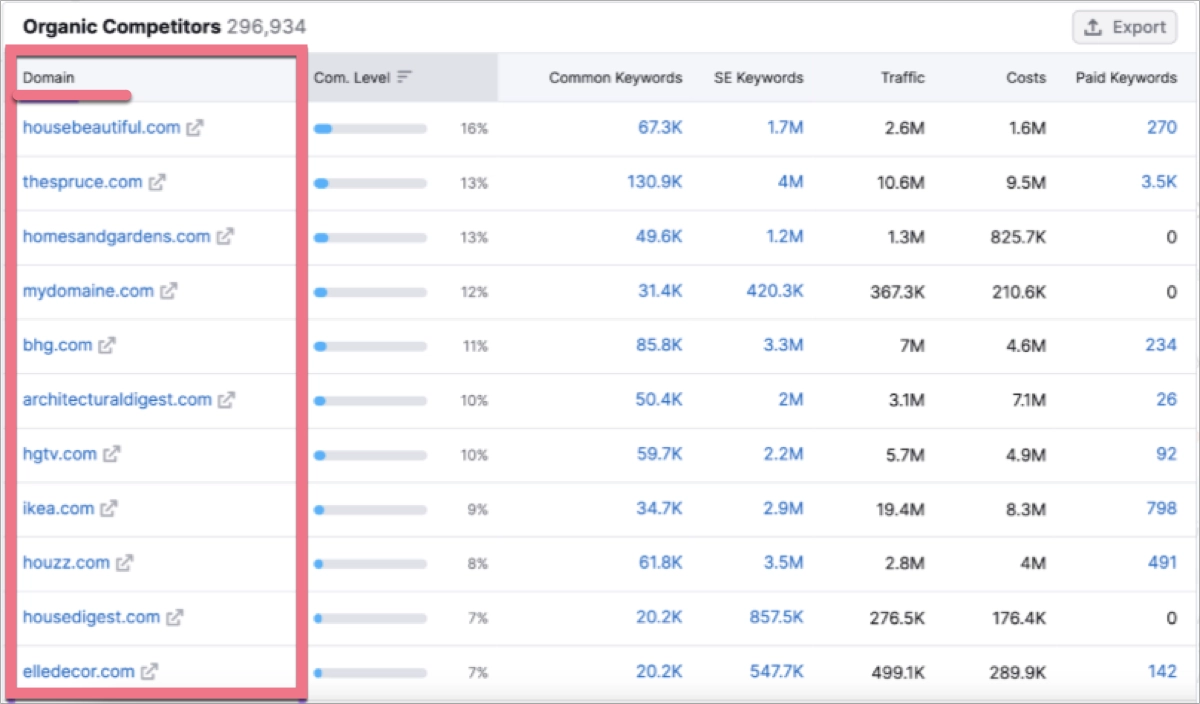
TIP: When using Ahrefs, focus on the Domain Rating metric (DR). It shows your competitors’ website authority, giving you a quick sense of their overall link power and how established they are in Google’s eyes.
3. Conduct Keyword Gap Analysis
Once you have determined direct SEO competitors, it’s time to analyze their strategies. The first step is to conduct a keyword gap analysis, which helps uncover which relevant search queries your competitors rank for but you do not.
Use the Ahrefs Competitive Analysis tool to compare your website with your competitors. This will help you evaluate keyword rankings and find phrases that they rank for but you don’t.
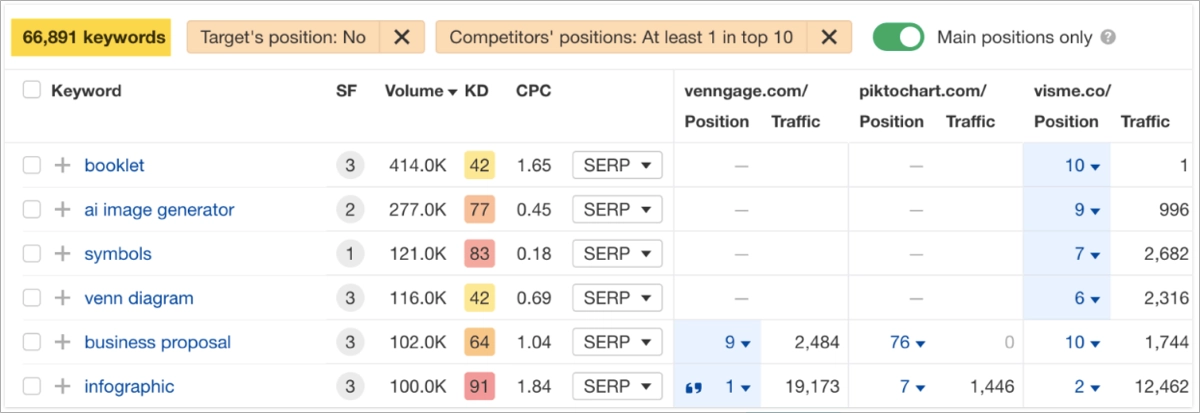
Focus on terms with traffic potential and clear intent, but remember that not all keywords are equally valuable to your business context. This step guides future keyword targeting by showing you where your content is lacking in both depth and coverage.
4. Evaluate Competitors’ Content Strategy
To evaluate competitors’ content strategy, review how they structure and optimize pages that rank for your target keywords. Analyze blog topics, word count, headings, and update frequency to identify patterns that attract search traffic.
Take a close look at the URLs on your competitors’ sites that are getting the most organic traffic – this will reveal the topics driving their visibility. Pay attention to the content that ranks for both informational searches (people looking to learn) and commercial searches (people ready to buy). When you compare this to your own site, you’ll likely uncover areas where your content is lacking. This could be in terms of the types of content you offer, the depth of your coverage on specific subtopics, or even just how well your internal links connect everything.
TIP: Manual review, combined with SERP analysis and content audit tools, will give you a complete picture of how your competitors’ strategy supports websites’ authority and rankings.
5. Evaluate Technical and On-Page SEO
Then, evaluate technical and on-page SEO aspects, as they reveal why specific competing sites may outrank you despite similar content quality. Start with a crawl using tools like Screaming Frog to assess loading speed, internal linking, structured data, and other technical SEO factors.
Then, analyze how effectively your competitors use title tags, headings, and meta descriptions to match search intent and improve click-through rates. While analyzing the title tags, focus on keyword integration, target keyword placement, and modifiers, like “best” or “free”.
Another critical aspect to evaluate is the URL structure, as it impacts both user experience and how easily search engines can understand and categorize content. Observing whether competitors incorporate keywords and maintain concise slugs can offer insights into their optimization strategies for clarity and crawlability.
This review can highlight areas where your own technical SEO might be lacking and demonstrate which specific optimization practices not only enhance visibility but also improve how search engines understand and navigate content.
Get ahead of your competition—build SEO-smart, high-converting landing pages with Landingi.
6. Analyze Competitors’ Backlink Profiles
Another critical step is analyzing competitors’ backlink profiles, as it helps you understand how their authority is built and which sources contribute to their rankings. By examining the quantity, quality, and diversity of their backlinks – including the types of websites linking to them (e.g., industry publications, educational institutions, other relevant businesses), the authority of those linking domains, and the anchor text used – you can gain valuable insights into successful link-building strategies within your niche.
Moreover, this analysis can reveal potential link opportunities for your own site, highlight authoritative sources you might be overlooking, and inform your outreach efforts to build a stronger backlink portfolio.
Google Search Console gives you a peek at your own backlinks. But if you want to see the whole picture for your competitors and, more importantly, find untapped link opportunities, you need a dedicated tool. Ahrefs Site Explorer enables generating a Link Intersect report for comprehensive competitor backlink analysis – it will generate a list of websites linking to your competitors’ websites but not yours. Knowing where and how competitors acquire links allows you to develop a more strategic, targeted link-building plan.
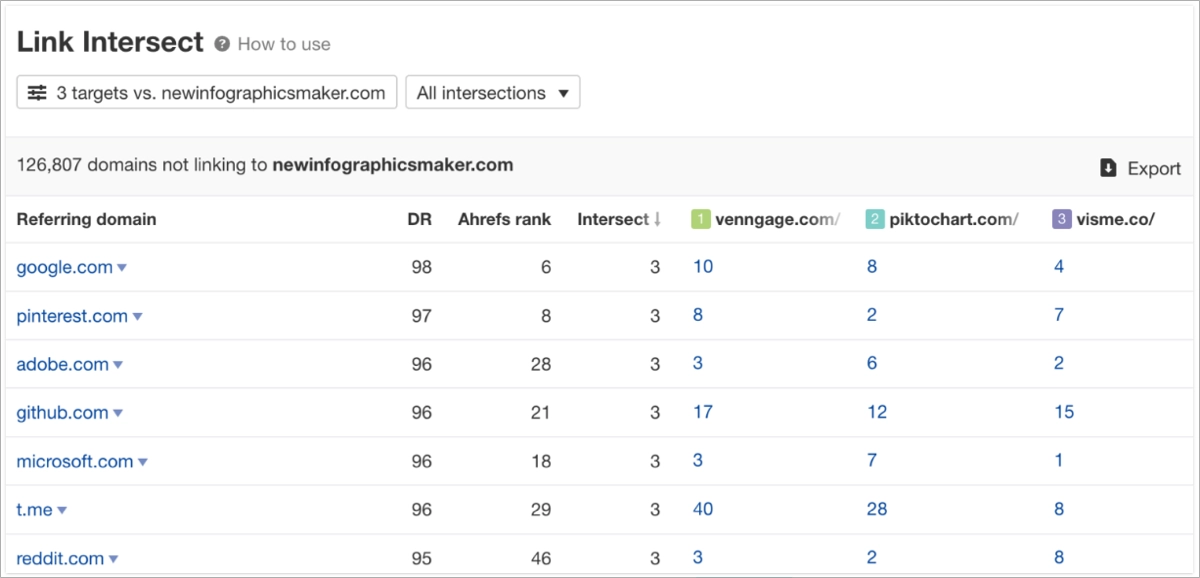
7. List Insights and Turn Them into Action
The next stage is where the raw data starts to tell a story. By putting your website side-by-side with your top search competitors, you can pinpoint what they’re doing more effectively, but it’s equally important to spot their weaknesses. See how reliably they show up in search results for the keywords that matter most to you, and then compare that to your own performance.
The point is to summarize where your competitors excel and where they fall short, and turn the insights you’ve gathered into specific changes that enhance your SEO performance. Adjust your content, technical setup, and link-building strategy based on what top-ranking pages are doing better, and fill any content or topical gaps on your own site. Focus on aligning your structure with what already performs well in organic search, but tailor it to your brand’s context and goals. A systematic, data-based approach to optimizing your SEO strategy increases your visibility in search engine results and positions your site for long-term growth.
How Often Should You Perform An SEO Competitor Analysis?
You should perform SEO competitor analysis regularly to stay aligned with ranking shifts and algorithm updates. The recommended frequency depends on your approach:
- Quarterly analysis is good enough for most businesses to track changes and new content.
- Monthly analysis is advisable in highly competitive industries or during growth phases.
- SEO competition analysis is a necessity after core updates, allowing reassessment of losses or gains and adapting the strategy.
Keeping the SEO competitor analysis process recurring makes adjustments timely and ensures strategic relevance. This makes SEO competitor analysis important for maintaining and improving rankings.
What Is the Role of Competitor Analysis in Landing Page SEO?
The role of competitor analysis in landing page SEO is to guide the creation and optimization of web pages that are both semantically relevant and competitive in search engine rankings. When you look at how top-performing pages are structured – across headings, content depth, and user experience – you start to understand what Google is currently valuing in your specific area. This includes analyzing layout, media use, and how the value proposition is conveyed above the fold.
One of the main goals is to identify keywords your competitors are ranking for, especially on pages designed for conversions. Dedicated tools help you compare landing page-level metrics such as estimated search traffic, bounce rate, and conversion intent. Additionally, when cross-referenced with paid search data, this analysis can highlight high-intent queries where organic presence should be prioritized to reduce dependency on paid channels.
Competitor analysis also reveals what kind of content formats and engagement tactics work best (such as FAQs, trust signals, CTAs, or testimonials), and how these influence user behavior and on-page retention. Once you know what works for your competitor, you can build your own landing page employing these elements. However, visibility in search engines is just half of the success.
Landing pages’ primary purpose is most often to drive conversions – when well-optimized, they not only help you build your online presence, but also transform that visibility into tangible business results, like leads, sales, or sign-ups. To achieve the most from your pages, use a professional landing page automation platform – Landingi. It helps optimize pages for SEO by providing precise control over on-page elements critical to search engine visibility.

Its AI landing page features, including an SEO copy generation tool, allow you to generate titles and descriptions tailored to your page’s content, ensuring it’s more likely to attract relevant traffic from search engine results and improve click-through rates. The platform also supports fast-loading, mobile-responsive templates that meet technical SEO standards, improving crawlability and user experience – you can simply pick one of over 400 pre-designed pages and customize it in a drag-and-drop editor to align your brand and offer.
Additionally, built-in A/B testing helps refine content and layout for better engagement, indirectly boosting SEO signals like dwell time and conversion rate. Together, these features make Landingi a practical solution for creating landing pages that rank and convert.
Use what you learn to win! Create landing pages that outperform your rivals with Landingi.
Ultimately, by integrating findings from competitor pages and leveraging landing page SEO optimization tools, you improve your chances of attracting qualified organic traffic, increasing conversions, and outperforming rivals across high-value search terms. This ensures that your landing pages are not only indexed but positioned to dominate for targeted commercial intents.
What Are the Best SEO Competitor Analysis Tools?
Among the best SEO tools for competitor analysis, Ahrefs and Semrush are often considered industry–leading platforms, but other excellent options include Moz Pro or Similarweb. The best choice often depends on your specific needs and budget, as each tool offers a unique set of strengths and features for in-depth competitive research.
Ahrefs
Ahrefs is a go-to tool for many SEO professionals, mainly because of its huge backlink index and its ability to track keywords effectively. You can easily perform a keyword gap analysis to see where your competitors have an edge, dive deep into their backlink profiles, and determine what content performs best for them. The Site Explorer and Competitive Analysis features are helpful for understanding which searches they’re ranking for and where your site is lagging. Plus, the traffic estimates for individual pages are a real bonus for prioritizing valuable content topics.
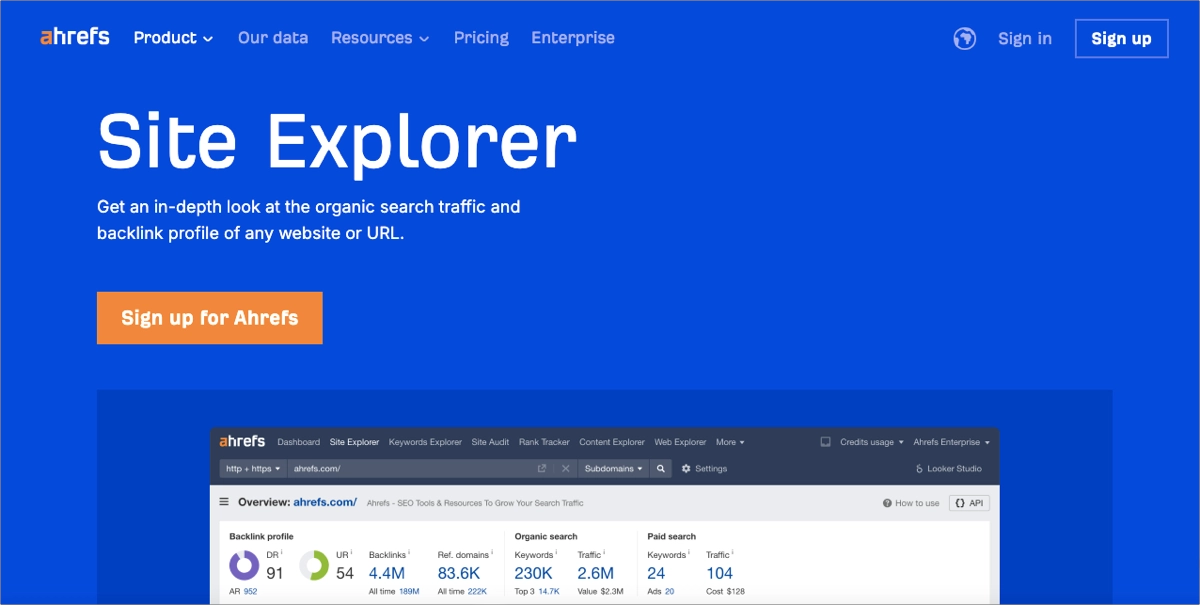
Semrush
Semrush provides a pretty complete toolkit for understanding what your competitors are doing in both organic search and paid ads. You can use their Keyword Overview to get the details on specific keywords, the Keyword Gap tool to find missed opportunities, and Organic Research to track their rankings and content performance. What’s also really useful is how it connects with Google tools and gives you detailed reports on search results features, which helps you make smart adjustments to your content and metadata.
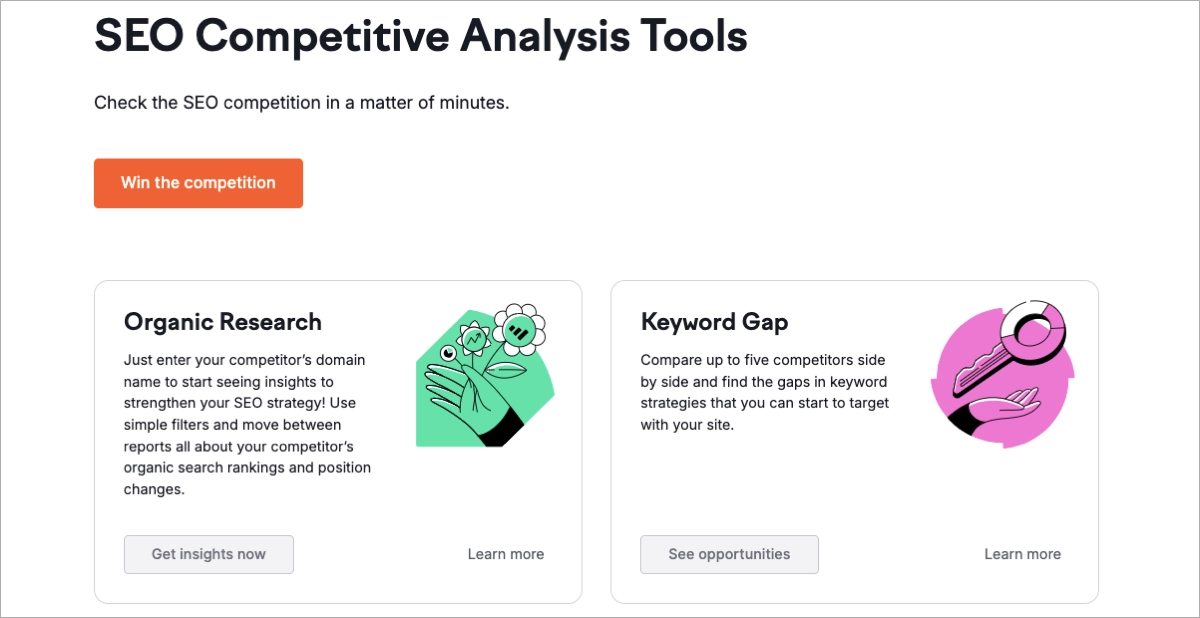
Moz Pro
Moz Pro is a solid choice, valued for its user-friendly interface and proprietary Domain Authority score, which gives you a good benchmark for comparing your website’s strength to others. Their Keyword Explorer helps you find promising keywords, and the Competitive Research tools let you see how your key SEO metrics stack up against your rivals. Plus, if you’re a smaller business focused on a specific local area, Moz Pro has useful features dedicated to local SEO competitor analysis.
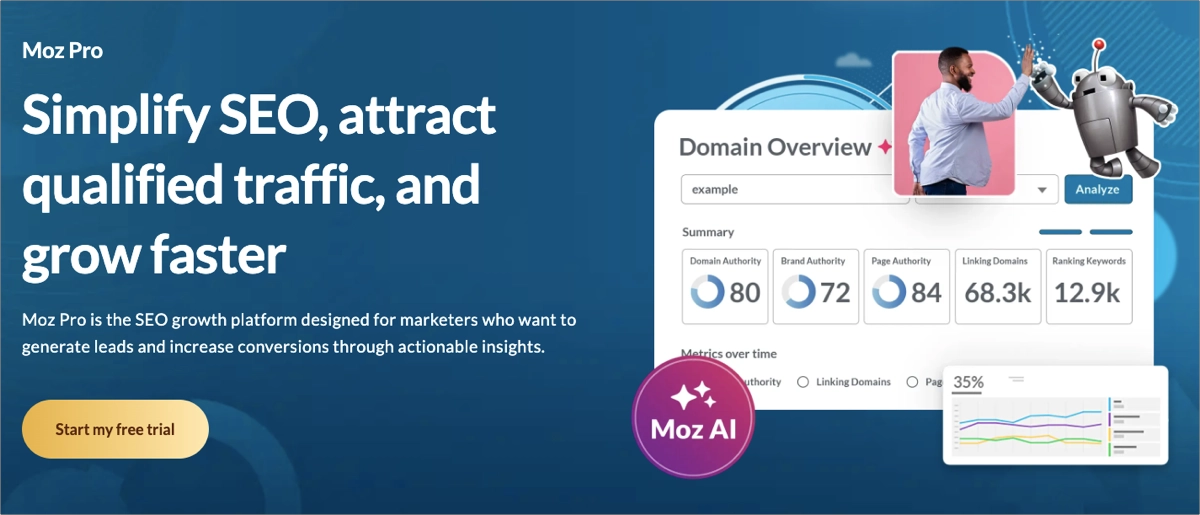
Smilarweb
Similarweb offers Web Intelligence tools perfect for comprehensive SEO competitor analysis. In addition to keyword research and backlink analytics, Similarweb gives a broad view of how users arrive at competitor websites. It breaks down traffic into organic, direct, referral, social, and paid, offering insight into overall digital strategy. While it lacks some of the granular SEO features of Ahrefs or Semrush, it excels in competitive benchmarking and high-level performance tracking.
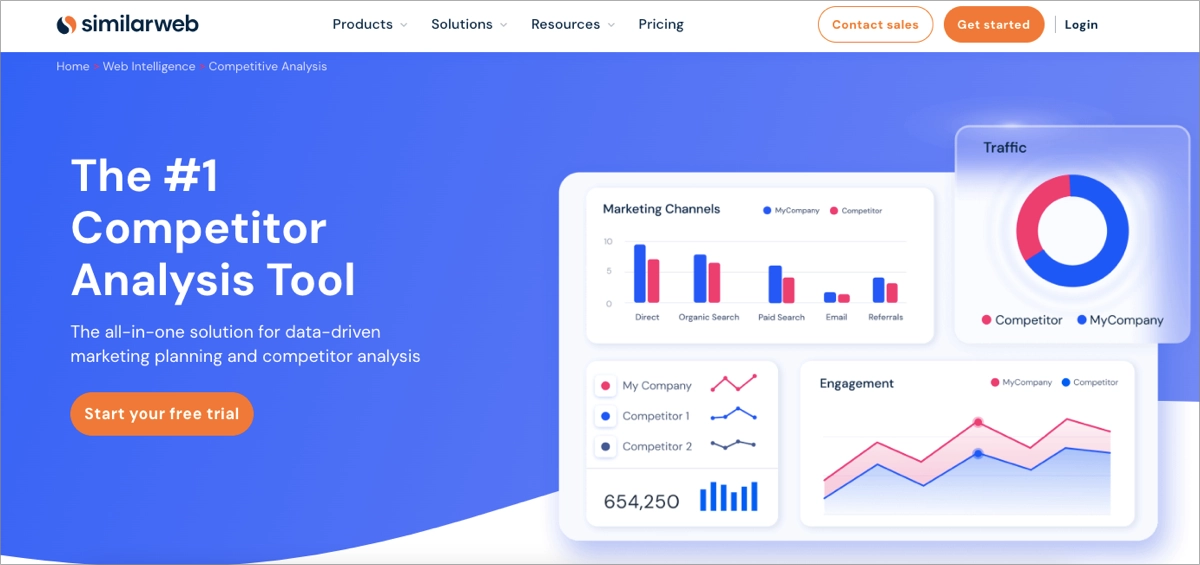
Ultimately, these tools give you a complete picture of what your competitors do in SEO – from the content they create and the links they earn to their website traffic and overall authority. That makes them crucial for building a strategy based on what’s actually working in the market. Take a look at how they stack up and pick the one that gives you everything you need:
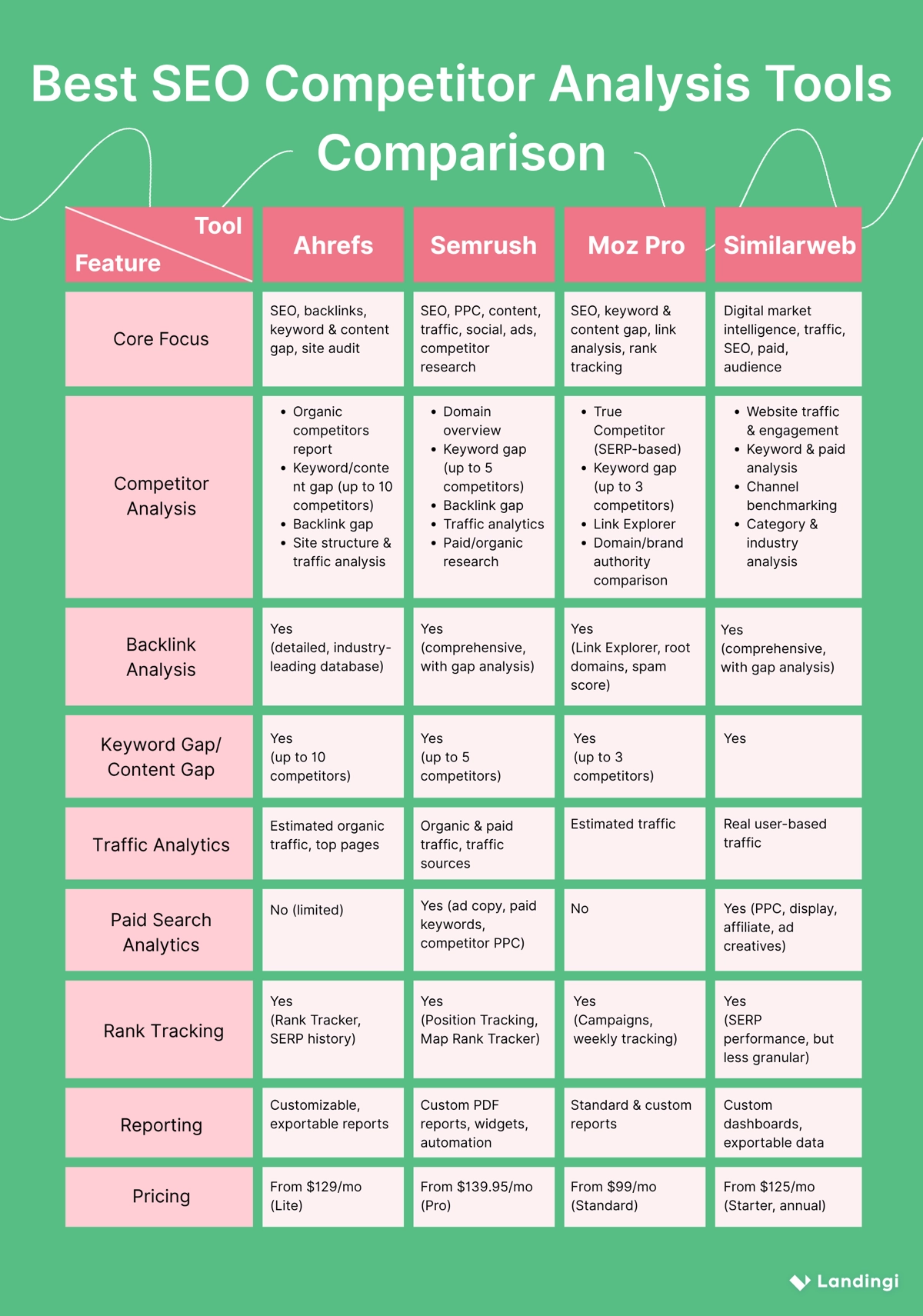
Where to Find an SEO Competitor Analysis Template?
You can find templates to help you with SEO competitor analysis from a few trusted sources, including dedicated SEO platforms, digital marketing agency websites, and industry blogs. For instance, Semrush’s My Reports tool offers customizable templates that combine competitor keyword data, backlink audits, and traffic analysis in one place.
Attrock, a digital marketing agency, provides downloadable SEO templates on their blog and resource pages tailored for structured audits. ClickUp also offers free SEO competitor analysis templates as part of their marketing workspace tools, useful for tracking tasks and insights collaboratively.
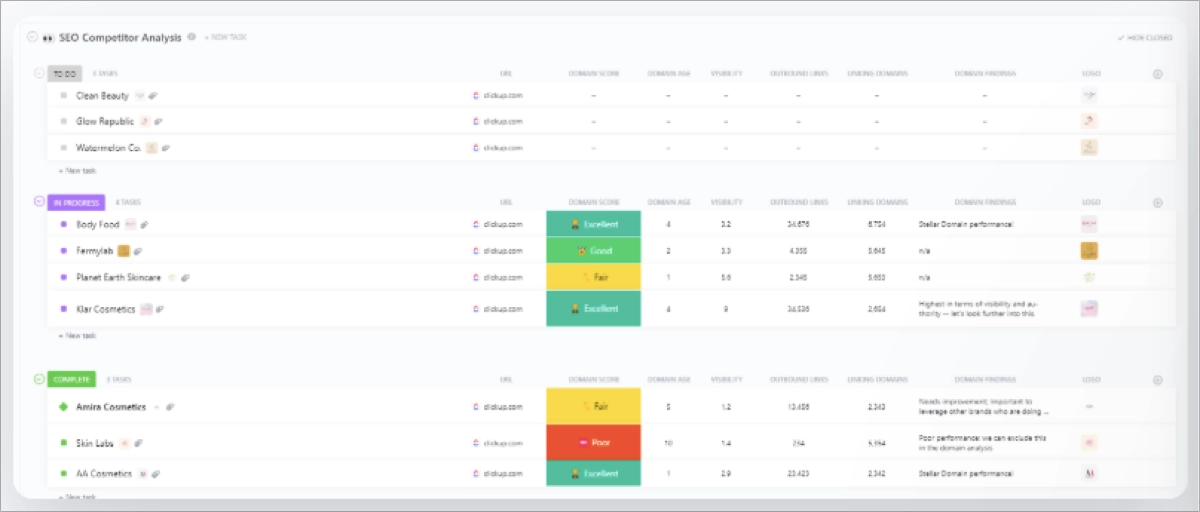
What Are the Limitations of SEO Competitor Analysis?
The limitations of SEO competitor analysis include incomplete data, shifting algorithms, non–public ranking factors, and differences in brand authority. While it’s helpful to see what’s ranking, this process doesn’t always tell the whole story behind why a page gets the top spot. Search engines also take into account things like how much they trust a website and how users interact with it, which aren’t always easy to track with numbers.
Sometimes, really authoritative websites can outrank others with similar content just because of their history or because people often search for them by name. So, while SEO competitor analysis is an excellent guide for your decisions, never let it replace original research or a context-driven SEO strategy.
Outperform Competitors with Well-Optimized Landing Pages
Competitor analysis in SEO is not just about tracking others. It’s about translating insights into structural, semantic, and strategic improvements. By going through it step by step – from figuring out who your main online rivals are to making your content and technical SEO better – you can actually see a difference in how visible you are in search results. Ultimately, the idea is to make it easier for Google to understand and rank your pages while ensuring you’re seen as a go-to source on your topics.
Well-optimized landing pages are where this advantage becomes actionable. They must target the right keywords, load fast, offer clear value, and follow on-page SEO best practices seen in top-performing pages. Using a platform like Landingi streamlines this process through automation, ensuring optimized layouts, giving you full control over SEO elements, and allowing you to implement data-backed changes quickly – keeping you ahead in organic search. Try it now and see the difference!

